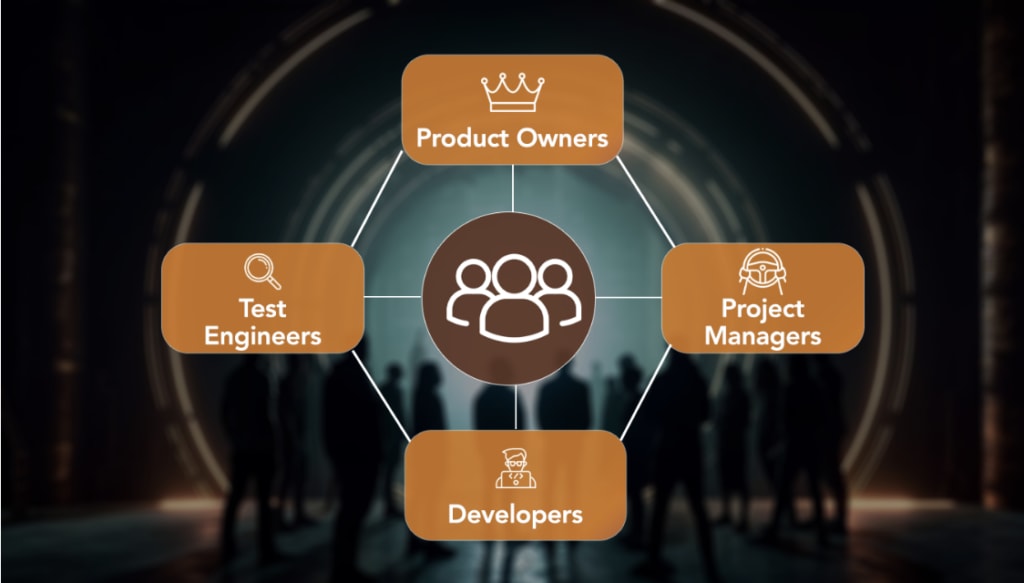Software Development Team: Structure, Roles, and Tips
Software Development

Navigating the complexities of software development team structure is essential for any project’s triumph. Comprising multidisciplinary expertise, these teams are the driving force in turning abstract ideas into robust software solutions. Success hinges not just on individual skill, but how effectively these skills are orchestrated within the team. The team’s architecture is shaped by diverse factors including the project’s breadth, its technical intricacies, time constraints, and budgetary ceilings. With stages varying from discovery to MVP development, each phase demands a bespoke constellation of competencies, encompassing software development team roles such as product owners, project managers, developers, and test engineers.
Embracing the right methodology is crucial for managing a software development team. Agile endorses a self-managed structure encouraging adaptability and iterative progress, while Waterfall offers a more controlled, step-wise progression. Typically, the likes of business analysts, software architects, UX/UI designers, and developers form the core of these teams, each role seamlessly connecting tech ambitions with business results. Hence, mastering the art of software development team management becomes a pivot for gear-turning efficiency and innovation within a development group.
Understanding how to manage a software development team begins with outlining clear roles, fostering collaboration, and ensuring financial allocation is suitably aligned with team requirements. Here, we unfold the strategic essence and best practices crucial for leading, organizing, and nurturing software development teams toward the pinnacle of their potential and beyond.
Key Takeaways
Effective software development teams are tailored to the precise demands of the project scope and complexity.
Selecting the appropriate software development methodology is pivotal to the team’s operational success.
Defined roles within the team, such as business analysts and UX/UI designers, bridge the gap between business needs and technical execution.
Agile and Waterfall methodologies influence the managerial tactics of a software development team.
Leadership in software development requires a balance of strategic oversight and empowering team autonomy.
Strategic collaboration and clear communication are the cornerstones of managing a software development team efficiently.
Introduction
Embarking on the journey of building a software development team demands a nuanced understanding of the methodologies that will be employed. The selection between an Agile software development team structure and a traditional software development team structure carries profound implications for the project’s lifecycle. It influences everything from ideation to delivery, touching upon the collaborational dynamics of the team and the efficiency of the workflows established. This pivotal decision echoes throughout the project, underscoring the importance of aligning the development process with the project’s goals and the team’s capabilities.
Understanding the Software Development Process
In exploring the underpinnings of software development, one encounters a spectrum of methodologies. Traditional models delineate a clear, step-by-step approach, encapsulated by the Waterfall methodology. This established framework lays out a series of defined, sequential phases, each resting on the completion of its predecessor, and is often characterized by its top-down management style. Here, change is anathema – it disrupts the tightly held sequence of operations.
In direct contrast stands the Agile model – a beacon of flexibility and adaptation. Rooted in the principle of iterative development, this approach invites client participation, champions feature prioritization, and thrives on cross-functional team collaborations that bleed across development stages. The Agile manifesto’s embrace of change and continuous feedback creates a lively environment where software solutions can evolve in real-time, tethered closely to client needs and market dynamics.
The Structure of a Software Development Team
Delving into the fabric of a software development team, it’s clear that its foundation is layered with not just skills, but a symbiotic structure that encapsulates the roles and expectations at its core. The way a team is woven together can spell the difference between success and struggle, emphasizing the need for software development team management to be both adept and insightful. From fostering the strategic vision necessary in a team lead for software development to establishing a typical software development team structure, the edifice of a development team is nothing short of crucial for a project’s prosperity.
Typical Software Development Team Structure
A typical software development team exemplifies a diverse ecosystem of roles, each a cog in the vast machine of product development. The composition – whether it’s a business analyst who deciphers complex customer needs into actionable instructions, or a DevOps engineer deftly orchestrating code deployment – this coordinated team synergy is paramount. Roles are designated not merely by title, but by the unique value and expertise each member brings to the table, with a clear allocation of tasks and responsibilities that is indispensable in achieving the shared project objectives.
Agile Software Development Team Structure
Agile methodologies pivot on the tenet of flexibility, with structures that anticipate and embrace change. Unlike their traditional counterparts, Agile software development teams champion a flat hierarchy where roles meld fluidity with distinction. In such dynamic environments, the emphasis is placed on the team’s collective ability to adapt to evolving project requirements while maximally adding to customer value. Here, each member is a torchbearer of progress, committed not just to their individual output but to the progression of the team as a whole. This approach capitalizes on each individual’s insight, thus influencing the trajectory of the development process.
Read more here: Software Development Team Structure
About the Creator
Isha Khan
We assist start-ups in faster emergence and established companies in digitalizing smoothly. The development office is located in Eastern Europe and Asia with the headquarters in the Netherlands (Amsterdam) and the USA (Las Vegas).
Enjoyed the story? Support the Creator.
Subscribe for free to receive all their stories in your feed. You could also pledge your support or give them a one-off tip, letting them know you appreciate their work.






Comments
There are no comments for this story
Be the first to respond and start the conversation.